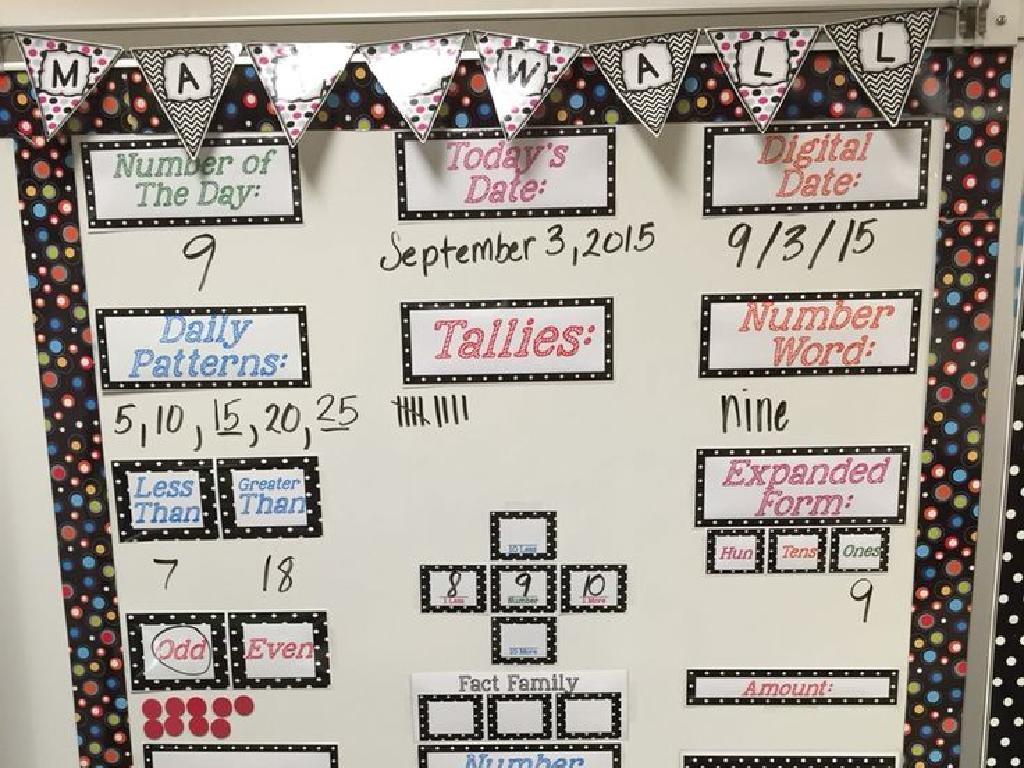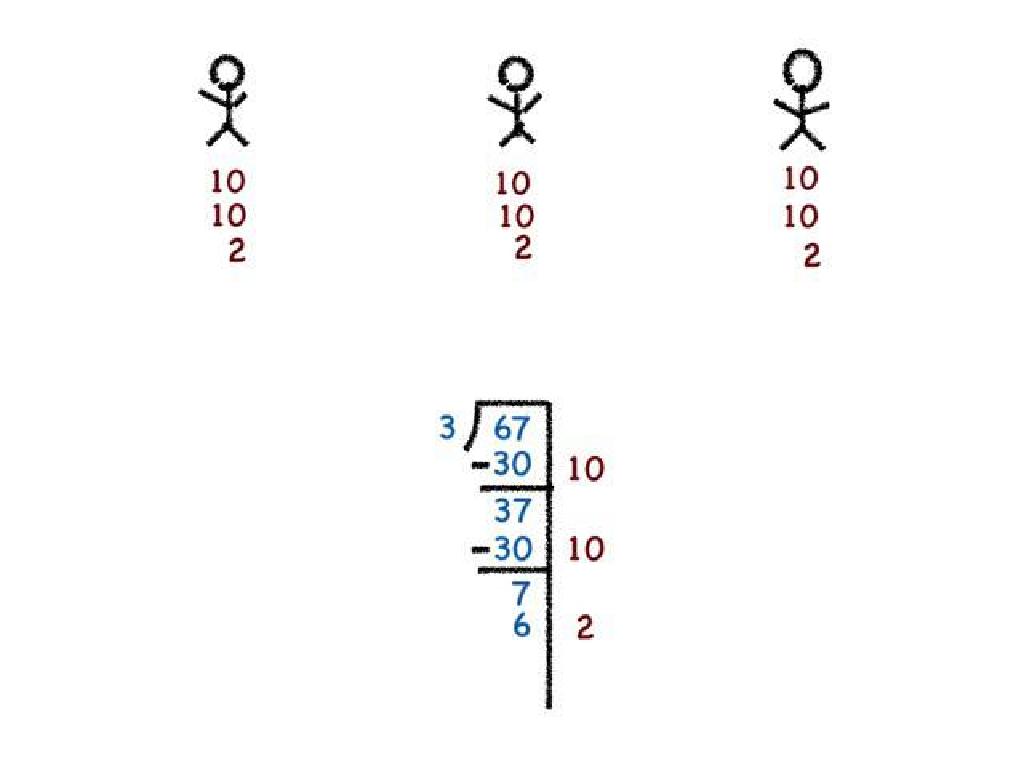Multiply Powers: Variable Bases
Subject: Math
Grade: Eighth grade
Topic: Exponents
Please LOG IN to download the presentation. Access is available to registered users only.
View More Content
Multiplying Powers with Variable Bases
– Exponents represent repeated multiplication
– Recap: Exponents have a base and an exponent
– For example, in 2^3, 2 is the base, 3 is the exponent
– Today’s focus: Multiplying variable bases
– Variables with exponents can also be multiplied
– Rule: When bases are same, add the exponents
– Apply this rule to x^2 * x^3 = x^(2+3) = x^5
|
Begin with a brief review of what exponents are and how they are used to represent repeated multiplication. Ensure students recall the parts of an exponent: the base and the exponent. Today’s lesson will focus on multiplying powers when the bases are variables. Introduce the rule for multiplying powers with the same base: add the exponents. Provide examples with variable bases, such as x^2 * x^3, and demonstrate how to apply the rule by adding the exponents to get x^5. Encourage students to practice with different variables and exponents to solidify their understanding.
Understanding Powers: Base and Exponent
– Define a power in math
– A power represents repeated multiplication of a number, e.g., 3^4 means 3*3*3*3
– Components: base and exponent
– Base is the number being multiplied; exponent tells how many times, e.g., in 3^4, 3 is base, 4 is exponent
– Reading powers correctly
– Say ‘3 to the fourth power’ or ‘3 raised to 4’
– Examples of simple powers
– 2^3 = 2*2*2 = 8, 5^2 = 5*5 = 25
|
This slide introduces the concept of powers in mathematics, focusing on the definition and components of a power. The base is the number that is being multiplied by itself, and the exponent indicates how many times the base is used as a factor in the multiplication. It’s crucial to teach students the correct way to read powers aloud to avoid confusion. Provide simple examples to illustrate the concept, such as 2 raised to the 3rd power equals 8. Encourage students to practice with additional examples to solidify their understanding.
Multiplying Powers with the Same Base
– Rule: Keep the base, add exponents
– When bases are the same, just add the exponents
– Example: x^3 * x^2 = x^(3+2)
– Multiplying x cubed and x squared gives x to the power of five
– Practice Problem: Simplify y^4 * y^3
– Apply the rule to simplify y to the seventh power
|
This slide introduces the rule for multiplying powers with the same base, which is a fundamental concept in working with exponents. The rule is straightforward: when multiplying two exponential expressions with the same base, keep the base and add the exponents together. The example provided uses variable x to demonstrate this rule. For the practice problem, students should apply the rule to simplify the expression y^4 * y^3. The expected result is y^(4+3) or y^7. Encourage students to work through the practice problem and verify their understanding of the rule. This concept is crucial for algebraic manipulation and solving more complex equations involving exponents.
Multiplying Powers with Different Bases
– Direct multiplication of different bases
– When bases cannot be combined
– Bases must be the same to combine exponents
– Example: x^2 * y^3
– x^2 * y^3 cannot be simplified further as bases differ
– Simplification rules for exponents
– Learn the rules to simplify expressions with same bases
|
This slide addresses the concept of multiplying powers when dealing with variable bases. Students often question whether they can multiply different bases directly; it’s crucial to clarify that bases must be identical to combine exponents. For example, x^2 multiplied by y^3 does not simplify further because the bases (x and y) are different. Emphasize that simplification rules for exponents apply only to like bases. Provide additional examples and practice problems where students can apply these rules to reinforce the concept. Encourage students to identify the base of an exponent and to only combine like terms.
Let’s Practice Together: Multiplying Powers
– Simplify (a^3)(a^5)
– Add exponents when bases are same: a^(3+5)
– Simplify (m^2)(m^4)(m^3)
– Add exponents for m: m^(2+4+3)
– Simplify (x^2)(y^2)
– Different bases, keep separate: x^2y^2
|
This slide is a class activity focused on practicing the multiplication of powers with variable bases. For example 1, guide students to understand that when multiplying powers with the same base, we add the exponents. The same rule applies to example 2 with multiple instances of the same base. For example 3, emphasize that when the bases are different, we simply multiply the terms as they are. Encourage students to work through these examples individually or in small groups, and then discuss the answers as a class. Provide additional similar problems for students to solve and ensure they grasp the concept of adding exponents when bases are the same and keeping terms separate when bases differ.
Special Cases: Multiplying Powers with Variables
– Multiplying powers with coefficients
– Coefficients are multiplied separately from the bases, e.g., 2x^3 * 3x^2 = 6x^5
– Understanding the zero exponent rule
– Any base with an exponent of zero equals one, e.g., x^0 = 1
– Multiplying with negative exponents
– When multiplying, add exponents; negative exponents indicate division, e.g., x^-2 * x^3 = x^(3-2) = x^1
– Behavior of negative exponents
– Negative exponents flip the base to the denominator, e.g., x^-1 = 1/x
|
This slide covers the special cases encountered when multiplying powers with variable bases. Start by explaining how to handle coefficients, emphasizing that they are treated separately from the bases and are multiplied together. Then, introduce the zero exponent rule, ensuring students understand that any number (except zero) raised to the power of zero is one. Next, explain negative exponents, showing that they represent the reciprocal of the base raised to the positive exponent. When multiplying variables with negative exponents, students should add the exponents, keeping in mind the sign. Provide examples for each case and encourage students to solve similar problems to reinforce the concepts.
Class Activity: Exponent Bingo
– Receive your unique Bingo card
– Listen for called-out expressions
– Match expressions to your card
– Expressions include powers with variable bases
– Aim for five in a row to win!
|
This interactive class activity is designed to help students practice and reinforce their understanding of multiplying powers with variable bases. Each student will receive a Bingo card filled with various power expressions. As the teacher, you will call out simplified expressions, and students will need to match these to the corresponding expressions on their Bingo cards. The goal is for students to recognize and connect the simplified expression with its expanded form. This activity encourages active participation and provides a fun way to engage with the material. Be prepared with a list of expressions to call out and ensure that each Bingo card has a good mix of difficulty levels. Consider offering a small prize for the winners to motivate participation.
Homework and Wrap-up: Multiplying Powers
– Complete the practice worksheet
– Focus on multiplying powers with variable bases.
– Study for the exponent quiz
– Quiz will cover all exponent rules learned.
– Review today’s lesson
– Go over your notes and try additional problems.
– Bring any questions next class
|
The practice worksheet is designed to reinforce students’ understanding of multiplying powers with variable bases. Encourage them to attempt all problems and check their answers with the key provided. Remind students that the upcoming quiz will assess their knowledge of all exponent rules discussed in class, including multiplying powers, power of a power, and dividing powers. They should review their notes, revisit today’s lesson, and practice additional problems to prepare. Let students know they can bring up any questions or difficulties they encounter at the start of the next class for clarification.





